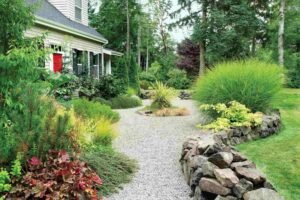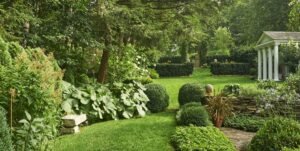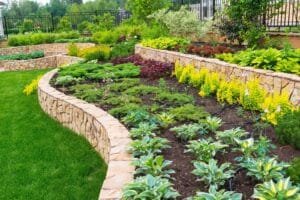Landscaping involves the use of various building materials to create outdoor spaces that are functional, visually appealing, and environmentally sustainable. Building materials for landscaping are used to construct hardscapes, which are the non-living elements of a landscape, such as patios, walkways, retaining walls, and other structures. These materials play a crucial role in determining a landscape design’s durability, safety, aesthetics, and overall functionality. Many building materials are available for landscaping, each with unique characteristics, advantages, and limitations. Some common building materials used in landscaping include natural stone, brick, concrete, wood, metal, composite materials, and recycled materials. These materials can be used in various ways, such as for paving, wall construction, edging, and decorative features, to create diverse landscape designs to suit different styles, preferences, and budgets.
When choosing building materials for landscaping, factors such as the climate, soil conditions, site slope, maintenance requirements, and budget must be considered. For instance, natural stone may be ideal for a rustic or traditional landscape design. At the same time, concrete may be more suitable for a modern or contemporary style.
Additionally, sustainability and environmental impact are becoming increasingly important considerations in landscape design, with recycled materials, locally sourced materials, and materials with low carbon footprint gaining popularity.
Proper installation, maintenance, and care of building materials for landscaping are essential for ensuring their longevity, safety, and performance. It is crucial to follow industry best practices, local building codes, and manufacturer’s instructions to ensure that the materials are installed correctly and used to maximize their benefits while minimizing negative impacts on the environment. In conclusion, building materials for landscaping are critical components of landscape design, providing the necessary structure, functionality, and aesthetics to create outdoor spaces that are both beautiful and functional. Careful consideration of material characteristics, environmental impact, and maintenance requirements is essential in selecting and using building materials for landscaping to create sustainable, visually appealing, and functional landscapes.
How does Building material for landscaping work?
Building materials for landscaping are used to create hardscapes, which are the non-living elements of a landscape, such as patios, walkways, retaining walls, and other structures. These materials work together to provide landscape designs with the necessary form, functionality, and aesthetics. Here are some ways in which building materials for landscaping work:
- Paving: Building materials such as natural stone, brick, concrete, and composite materials create functional and visually appealing surfaces for patios, walkways, driveways, and other areas. These materials are chosen based on durability, slip resistance, aesthetics, and budget. Proper installation techniques, such as base preparation, leveling, and jointing, are followed to ensure a stable and long-lasting pavement.
- Wall construction: Building materials like natural stone, brick, concrete, and wood are used to construct retaining walls, garden walls, and other vertical structures in landscaping. These walls serve functional purposes such as soil retention, terracing, and defining spaces. They also add visual interest and create level changes in the landscape. Proper engineering and construction techniques, including appropriate foundation, drainage, and backfill, are employed to ensure the stability and safety of the walls.
- Edging: Building materials like metal, plastic, and composite materials are used as landscape edging to create clean borders between different landscape elements, such as lawns, flower beds, and pathways. Edging materials provide a neat appearance, prevent the spreading of plant materials, and help with erosion control.
- Decorative features: Building materials can be used for various decorative elements in landscaping, such as decorative stones, mulch, gravel, and other aggregates. These materials are used to add visual interest, create focal points, and enhance the overall aesthetics of the landscape design.
- Drainage: Building materials, such as gravel, sand, and drain pipes, are used for proper drainage in landscaping. They are strategically placed to facilitate water runoff, prevent erosion, and manage excess water, ensuring the landscape remains functional and sustainable.
- Sustainability: Building materials for landscaping can also contribute to sustainability efforts by using recycled materials, locally sourced materials, and materials with a low carbon footprint. These materials help reduce environmental impact and promote environmentally friendly practices in landscaping.
Overall, building materials for landscaping work together to create functional, visually appealing, and sustainable landscapes. Proper selection, installation, and maintenance of these materials are essential to ensure their durability, safety, and performance in landscape design.
Benefits of building materials for landscaping
Landscaping involves using various building materials to create functional and aesthetically pleasing outdoor spaces. Here are some benefits of using building materials for landscaping:
- Durability: Building materials such as stone, concrete, and brick are known for their durability, making them ideal for landscaping projects that must withstand harsh weather conditions, heavy foot traffic, or other wear and tear. They can last for many years without significant degradation, reducing the need for frequent replacements and maintenance.
- Versatility: Building materials offer a wide range of design options, allowing for creativity and versatility in landscaping. They can be used to create elements such as pathways, retaining walls, patios, fire pits, and water features, enabling you to design unique and functional outdoor spaces that suit your preferences and needs.
- Aesthetics: Many building materials used in landscaping, such as natural stone, timber, and decorative bricks, add a sense of elegance, charm, and visual appeal to outdoor spaces. They can enhance the overall aesthetics of a landscape and complement the surrounding environment, creating a visually pleasing and inviting outdoor living space.
- Functionality: Building materials can serve functional purposes in landscaping, such as providing stability to slopes with retaining walls, creating defined spaces with patios or decks, improving accessibility with pathways or stairs, or providing seating or gathering areas with benches or retaining walls. They can help optimize the functionality and practicality of outdoor spaces, making them more usable and enjoyable.
- Low maintenance: Some building materials used in landscaping, such as concrete pavers or composite decking, require minimal maintenance compared to natural materials like wood. This is because they resist decay, rot, pests, and fading. As a result, they generally require less cleaning, sealing, or staining, saving time and effort in landscape maintenance.
- Sustainability: Many building materials, such as reclaimed or recycled, can contribute to sustainable landscaping practices. They can reduce the demand for new materials, lower the environmental impact associated with manufacturing, transportation, and extraction of raw materials, and promote resource conservation and waste reduction.
- Increased property value: Well-designed and adequately installed landscaping with high-quality building materials can significantly enhance the value of a property. A beautifully landscaped outdoor space with functional and visually appealing features can increase a property’s curb appeal, attractiveness, and marketability, potentially leading to a higher return on investment.
In conclusion:
Using building materials in landscaping offers a range of benefits, including durability, versatility, aesthetics, functionality, low maintenance, sustainability, and increased property value. Consider incorporating suitable building materials into your landscaping projects to create beautiful, functional, and sustainable outdoor spaces.







